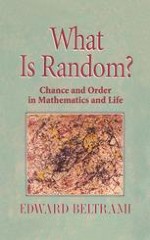(Not for distribution) We all know what randomness is. We sometimes choose between options "at random", and if we toss a coin we know it will land heads or tails at random. But are events like these truly random? Randomness turns out to be one of those concepts, like "solid matter" in physics, that works just fine on an everyday level but mysteriously disappears once we move in to examine its fine structure. In this fascinating book, mathematician Ed Beltrami takes a close enough look at randomness to make it mysteriously disappear. The results of coin tosses, it turns out, are determined from the start, and only our incomplete knowledge makes them look random. "Random" sequences of numbers are more elusive--they may be truly random, but Godel's undecidability theorem informs us that we'll never know. Their apparent randomness may be only a shortcoming of our minds. Mathematicians have even discovered a string of numbers that appears random--but when you reverse the string, it's completely deterministic! People familiar with quantum indeterminacy tell us that order is an illusion, and that the world is fundamentally random. Yet randomness is also an illusion. Then which is real? Perhaps order and randomness, like waves and particles, are only two sides of the same coin.
